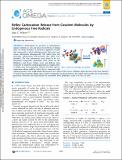Files in this item
Reflex carbocation release from covalent molecules by endogenous free radicals
Item metadata
| dc.contributor.author | Walton, John C. | |
| dc.date.accessioned | 2018-11-02T11:30:09Z | |
| dc.date.available | 2018-11-02T11:30:09Z | |
| dc.date.issued | 2018-10-31 | |
| dc.identifier | 256434321 | |
| dc.identifier | 12adb99c-9585-432a-8d90-c548cf407ad9 | |
| dc.identifier | 85055028475 | |
| dc.identifier | 000449026500109 | |
| dc.identifier.citation | Walton , J C 2018 , ' Reflex carbocation release from covalent molecules by endogenous free radicals ' , ACS Omega , vol. 3 , no. 10 , pp. 13290-13297 . https://doi.org/10.1021/acsomega.8b02307 | en |
| dc.identifier.issn | 2470-1343 | |
| dc.identifier.other | ORCID: /0000-0003-2746-6276/work/56638742 | |
| dc.identifier.uri | https://hdl.handle.net/10023/16380 | |
| dc.description | J.C.W. thanks EaStCHEM for financial support. | en |
| dc.description.abstract | Carbocations are pervasive in contemporary organic synthesis, so new and innocuous methods of making them are always desirable. A theoretical approach revealed that compounds in which radical generation takes place may release carbocations advantageously. The radical types and molecular substructures that promote this effect were identified. The best substructures were found to be 1,3-dicarbonyl compounds, particularly those based on the Meldrum's acid theme. Sulfate esters and dithiane rings could also be employed. Radicals generated on oxygen atoms or ethyne units were particularly effective. For these species, carbocation release could be reflex, that is, concurrent with radical generation. Only small radical enhancements were observed for release of lithium cations because of the ionic character of most of the precursors. Ethyne units could be incorporated as spacers between the radical center and the site of carbocation generation. Moreover, the enhancement was transmitted down polyethyne chains of at least six units. | |
| dc.format.extent | 8 | |
| dc.format.extent | 1345619 | |
| dc.language.iso | eng | |
| dc.relation.ispartof | ACS Omega | en |
| dc.subject | QD Chemistry | en |
| dc.subject | Chemistry(all) | en |
| dc.subject | Chemical Engineering(all) | en |
| dc.subject | NDAS | en |
| dc.subject.lcc | QD | en |
| dc.title | Reflex carbocation release from covalent molecules by endogenous free radicals | en |
| dc.type | Journal article | en |
| dc.contributor.institution | University of St Andrews. School of Chemistry | en |
| dc.contributor.institution | University of St Andrews. EaSTCHEM | en |
| dc.identifier.doi | https://doi.org/10.1021/acsomega.8b02307 | |
| dc.description.status | Peer reviewed | en |
| dc.identifier.url | https://pubs.acs.org/doi/suppl/10.1021/acsomega.8b02307 | en |
This item appears in the following Collection(s)
Items in the St Andrews Research Repository are protected by copyright, with all rights reserved, unless otherwise indicated.

